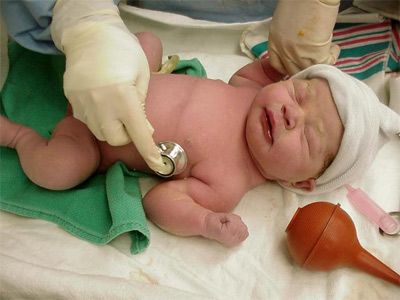Many patients wonder whether they'll need a cesarean. Sometimes your doctor knows the answer before labor even begins — if you have placenta previa, for example, or if the baby is in a transverse lie (that is, the baby is lying sideways within the uterus rather than head-down). But most of the time, neither you nor your doctor can know whether you'll need a cesarean until you see how your labor progresses and how your baby tolerates labor.
A cesarean delivery is performed in an operating room under sterile conditions. An intravenous line must be in place and a catheter put in the bladder.
Advertisement
After the patient's abdomen is scrubbed with antiseptic solution, sterile sheets are placed over her belly. One of the sheets is elevated to create a screen so that the expectant parents don't have to watch the procedure. (Although childbirth is usually an experience shared by both parents, a cesarean delivery is still a surgical operation.
Most doctors feel that the procedure is not something that expectant parents should watch, because it involves scalpels, bleeding, and exposure of internal body tissue that's normally not seen, which is disturbing to many people.)
The exact place on the woman's abdomen where the incision is made depends on the reason she's having the cesarean. Most often, it is low, just above the pubic bone, in a transverse direction (perpendicular to the torso). This cut is known as a Pfannensteil incision or, more commonly, a bikini cut. Less often, the incision is vertical, along the midline of the abdomen.
After the skin incision is made, the abdominal muscles are separated and the inner lining of the abdominal cavity, also called the peritoneal cavity, is opened to expose the uterus. An incision is then made in the uterus itself, through which the infant and placenta are delivered. The incision on the uterus can also be either transverse (most common) or vertical (sometimes called a classical incision), depending again on the reason for the cesarean and previous abdominal surgery. After delivery, the uterus and abdominal wall are closed with sutures, layer by layer. A cesarean delivery takes 30 to 90 minutes to perform.
Anesthesia for a C-section
The most common forms of anesthesia used for cesarean deliveries are epidural and spinal. Both kinds of anesthesia numb you from mid-chest to toes but also allow you to remain awake so that you can experience the birth of your child. You may feel some tugging and pulling during the operation, but you do not feel pain. Sometimes the anesthesiologist injects a slow-release pain medication into the epidural or spinal catheter before removing it in order to prevent or greatly minimize pain after the operation.
If the baby has to be delivered in an emergency and there's no time to place an epidural or spinal, general anesthesia may be needed. In that case, you are asleep during the cesarean and totally unaware of the procedure. Also, general anesthesia may be needed in some cases because of complications in pregnancy that make it unwise to place epidurals or spinals.
Advertisement



